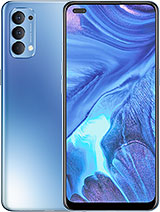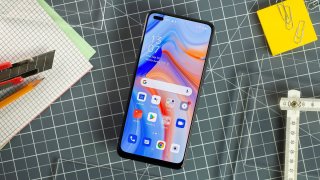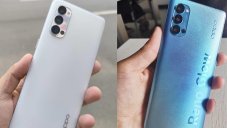Oppo Reno4
$302 | 26990
- 6.4" 1080x2400 pixels
- 48MP 2160p
- 8GB RAM Snapdragon 720G
- 4015mAh Li-Po
Phone Finder
- Acer alcatel Allview Amazon Amoi Apple Archos Asus AT&T Benefon BenQ BenQ-Siemens Bird BlackBerry Blackview BLU Bosch BQ Casio Cat Celkon Chea Coolpad Cubot Dell Doogee Emporia Energizer Ericsson Eten Fairphone Fujitsu Siemens Garmin-Asus Gigabyte Gionee Google Haier HMD Honor HP HTC Huawei i-mate i-mobile Icemobile Infinix Innostream iNQ Intex itel Jolla Karbonn Kyocera Lava LeEco Lenovo LG Maxon Maxwest Meizu Micromax Microsoft Mitac Mitsubishi Modu Motorola MWg NEC Neonode NIU Nokia Nothing Nvidia O2 OnePlus Oppo Orange Oscal Oukitel Palm Panasonic Pantech Parla Philips Plum Posh Prestigio QMobile Qtek Razer Realme Sagem Samsung Sendo Sewon Sharp Siemens Sonim Sony Sony Ericsson Spice T-Mobile TCL Tecno Tel.Me. Telit Thuraya Toshiba Ulefone Umidigi Unnecto Vertu verykool vivo VK Mobile Vodafone Wiko WND XCute Xiaomi XOLO Yezz Yota YU ZTE
Oppo Reno4 Summary
In the middle of last year, Oppo surprised us with the design of the original Reno: thin, flat, glass-sandwich design, and the "shark fin" design are completely different from the majority. However, the configuration and performance experience of this phone don’t justify the near-premium price (around Rs. 40,000) of the product. The Reno2 launched at the end of 2019 also follows the same “different” design, but the configuration continues to be inferior to other competitors in the price range.
Perhaps realizing that the beautiful design alone is not enough to convince users, Oppo has changed its strategy. From the Reno3 series and now the Reno4, the Chinese brand follows the trend and there is no metal frame / glass back. Not just that, the hardware configuration and price of the Reno series are getting better.
OPPO Reno4: Display
In addition to the punch hole design, the screen specs of the Reno4 are still the same as the Reno3, including a 6.4-inch AMOLED panel, Full-HD + resolution, 20: 9 ratio, 60Hz refresh rate, and HDR support.
Compared to Reno3's display, Reno4's default color mode (Vivid color mode) reproduces richer and bright colors as well as significantly higher brightness. When taking photos outside in the sun, the scene images displayed on the Reno4 screen are also bright, clear, and much easier to see. This shows that Oppo may have used the new AMOLED panel on the Reno4, which is better quality than that of its predecessor.
Unfortunately, unlike the Reno4 Pro, the Reno4’s display only has a 60Hz refresh rate instead of 90Hz. In addition, it is just a flat screen, not curved at two sides. Therefore, holding the Reno4 is not as comfortable as the Pro model.
OPPO Reno4: Performance
In terms of performance, both the Reno4 and Reno4 Pro use Snapdragon 720G chip with 8GB RAM. Based on performance measurement apps like Antutu and Geekbench, the Snapdragon 720G chip on the Reno4 is about 30% more powerful than Mediatek's Helio P90 chip on the Reno3. Specifically, Reno4 scored about 2,70,000 points on Antutu, in comparison to over 200,000 points on the Reno3. The graphics performance (GFX Bench) and the chipset performance (Geekbench) of this phone are also higher than those of the Reno3.
Try with a few familiar games like Dead Trigger 2 and PUBG Mobile, both Reno4 and Reno4 Pro have similar performance, smooth enough to play if you accept a little downgrade in graphics settings. With Dead Trigger 2, the Reno4 can play smoothly and stably at around 58-59 fps at the highest graphics settings. With PUBG Mobile game with heavier graphics, the device can play with a maximum of 40 fps without lagging in the "smooth" graphics setting, which is the graphics mode at the lowest level of the game. If you push the graphics settings in PUBG Mobile to a higher level, the fps will decrease significantly and the game no longer runs smoothly and stably.
Considering the other phones in the mid-range segment, such performance is reasonable for the Reno4, not too excellent but enough to use quite comfortably. 8GB of RAM is also enough for a comfortable multitasking experience, keeping lots of apps in the background.
In terms of software, Reno4 currently has a customized version of ColorOS 7.2 based on Android 10 like the Reno4 Pro. ColorOS 7.2 is the latest software version of Oppo, added with many new features.
OPPO Reno4: Battery life
Reno4 uses a 4,015 mAh battery, slightly smaller than the Reno3 (4,025 mAh). However, the device has been upgraded to VOOC 4.0 fast charging technology with a 30W capacity, compared to the 20W VOOC 3.0 on the Reno3. We have tested and found that it only took the Reno4 56 minutes to fully charge its battery with the included charger, of which the first 15 minutes charged 40% of the battery and the first 30 minutes charged 72%. Compared to Reno3's 85-minute full charge time, Reno4's charging speed shortens by nearly 30 minutes.
OPPO Reno4: Camera
The Reno4 and Reno4 Pro get the same quad rear camera cluster. In the front, the two machines use a 32MP main camera using Sony IMX616 sensor. Reno4 has a 2MP secondary camera in the selfie camera cluster to improve font removal efficiency.
Compared to the previous series, the Reno4’s quad rear camera cluster is nearly the same, except for the 2MP macro camera instead of the 13MP telephoto lens. This can be seen as a slight downgrade compared to the old one, perhaps to cut costs to compensate for improvements on the chipset, display, and charging technology.
The camera quality from the main 48MP rear camera of the phone is no different from the Reno3 and Reno4 Pro. Photos have natural colors and lots of detail. When shooting in low light, Reno4 does not try to "turn night into day" like some other phones. In most low-light shooting scenes, the camera only increases the light slightly compared to the scene so noise is well-controlled. Even when shooting in Night mode, the camera still does not boost the brightness but only improves the details.
The hardware is the same, so it is not surprising that the photos taken by the 8MP ultra-wide-angle camera on the Reno4 are not different from the Reno4 Pro and Reno3. Image quality is not that different from the ultra-wide-angle cameras on many recent mid-range smartphones, depending on lighting conditions. The image quality is quite beautiful in a well-lit environment but much worse than the main camera in low-light scenes.
Oppo Reno4 Full Specifications
- Dollas $302
- Rupee ₹26990
- Technology GSM / HSPA / LTE
- 2G bands GSM 850 / 900 / 1800 / 1900 - SIM 1 & SIM 2
- 3G bands HSDPA 850 / 900 / 1900 / 2100
- 4G bands LTE (unspecified)
- Speed HSPA 42.2/5.76 Mbps, LTE-A
- Announced 2020, July 29
- Status Coming soon. Exp. release 2020, August 05
- Dimensions 160.3 x 73.9 x 7.7 mm (6.31 x 2.91 x 0.30 in)
- Weight 165 g (5.82 oz)
- SIM Dual SIM (Nano-SIM, dual stand-by)
- Type Super AMOLED capacitive touchscreen, 16M colors
- Size 6.4 inches, 98.9 cm2 (~83.5% screen-to-body ratio)
- Resolution 1080 x 2400 pixels, 20:9 ratio (~411 ppi density)
- OS Android 10, ColorOS 7.2
- Chipset Qualcomm SM7125 Snapdragon 720G (8 nm)
- CPU Octa-core (2x2.3 GHz Kryo 465 Gold & 6x1.8 GHz Kryo 465 Silver)
- GPU Adreno 618
- Card slot microSDXC (dedicated slot)
- Internal 128GB 8GB RAM
- UFS 2.1
- Modules 48 MP, f/1.7, 26mm (wide), 1/2.0", 0.8µm, PDAF 8 MP, f/2.2, 119˚ (ultrawide), 1/4.0", 1.12µm 2 MP, f/2.4, (macro) 2 MP, f/2.4, (depth)
- Features LED flash, HDR, panorama
- Video 4K@30fps, 1080p@30fps
- Modules 32 MP, f/2.4, 26mm (wide), 1/2.8", 0.8µm
- Features HDR
- Video 1080p@30fps
- Loudspeaker Yes
- 3.5mm jack Unspecified
- WLAN Wi-Fi 802.11 a/b/g/n/ac, dual-band, Wi-Fi Direct, hotspot
- Bluetooth 5.0, A2DP, LE
- GPS Yes, with A-GPS, GLONASS, GALILEO, BDS
- Radio Unspecified
- USB 2.0, Type-C 1.0 reversible connector, USB On-The-Go
- Sensors Fingerprint (under display, optical), accelerometer, gyro, proximity, compass
- Non-removable Li-Po 4015 mAh battery
- Charging Fast charging 30W VOOC 4.0
- Colors Galactic Blue, Space Black
Oppo Reno4 News

Mobile - Jan 06, 2021
Oppo Reno 4 5G Price In India: A Do-It-All Mid-Range Smartphone

Mobile - Jun 06, 2020
OPPO Reno4 & Reno4 Pro Go Official: SND 765G & 65W Fast Charging

Mobile - May 27, 2020











